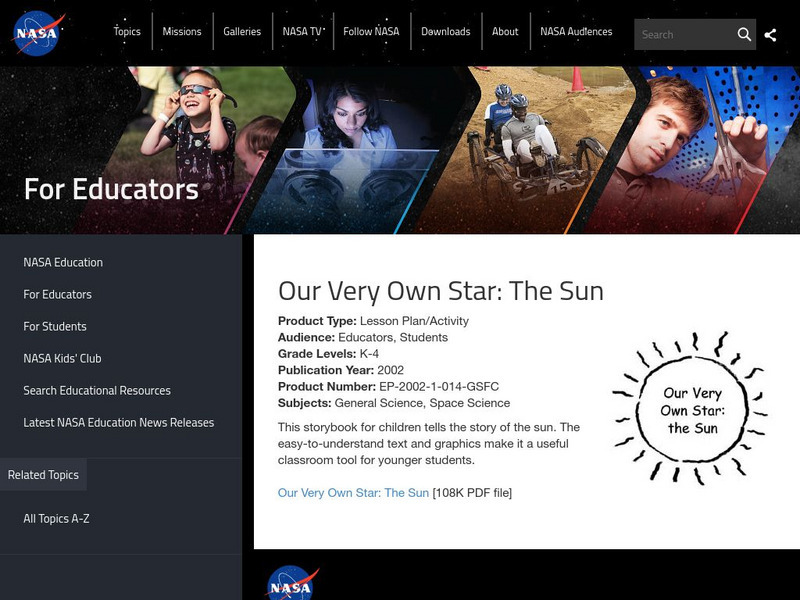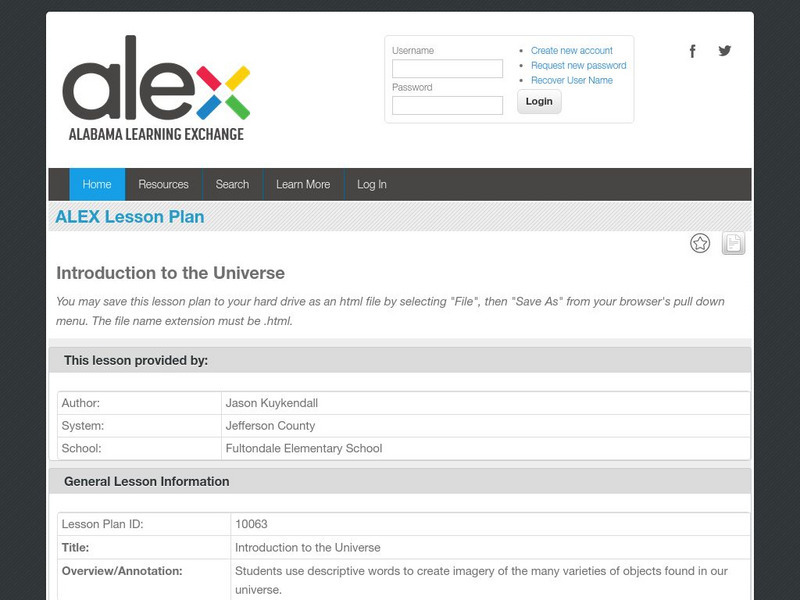Lerner Publishing Group
Lerner Classroom: Teaching Science Through Literacy
In this lesson plan, students will gather evidence to support the argument that differences in the apparent brightness of the sun compared with other stars is due to their relative distances from Earth. Students will also write texts in...
NC State University
Ncsu.edu: Adventures of the Agronauts
This site is an online science curriculum on how to grow plants on the Moon. There are six lessons that have a glossary also included. There are movies that demonstrate concepts, and teacher resources. The sites topics cover, the Earth,...
NC State University
Adventures of the Agronauts
Come along with the Agronauts and discover space in order to report back to Commander Spud Goodroot. Fun site provides all types of information about space science! Various missions include: 'What's In Our Sky?', 'The Root of the...
Project Britain
Primary Homework Help: Earth and Space Quiz
This resource provides information about Earth and space. In addition, there is a quiz provided.
NASA
Nasa: Classroom Activity: Our Very Own Star: The Sun
This PDF storybook for children tells the story of the sun. The easy-to-understand text and graphics make it a useful classroom tool for younger students.
PBS
Pbs Learning Media: What Causes the Gulf Stream?
This video segment adapted from NOVA uses satellite imagery to illustrate the Gulf Stream's path and animations to explain how atmospheric phenomena cause it to move. [1:51]
Next.cc
Next: Solar Energy
Engage in the activities provided to learn how you can use the sun as a source of energy. Click on the links for further exploration.
Alabama Learning Exchange
Alex: Introduction to the Universe
Students use descriptive words to create imagery of the many varieties of objects found in our universe.
Cool Math
Coolmath: Science Monster: Our Sun
Find out about our closest star, the sun. Read interesting facts and other trivia about our planet's source of energy.
Alabama Learning Exchange
Alex: The Sun and the Earth
The students will understand the relationship between the Earth and the sun and how this relationship affects observable phenomena on Earth, such as the seasons. The activity will help students learn about these concepts and will...
Khan Academy
Khan Academy: Gallery: Earth & Solar System
A gallery of pictures of the cosmic beauty of the Sun, our Solar System, and exoplanets. Pictures include a caption of what the viewer is looking at.
The Wonder of Science
The Wonder of Science: Ms Ess1 1: Earth Sun Moon System
Develop and use a model of the earth-sun-moon system to describe the cyclic patterns of lunar phases, eclipses of the sun and moon, and seasons.
University Corporation for Atmospheric Research
Ucar: Regions and Features of the Sun
Regions or "parts" of the Sun as well as features and phenomena that appear on the Sun or in its atmosphere.
University Corporation for Atmospheric Research
Ucar: Sun & Space Weather Memory Game
Test your memory while you learn about the Sun, space weather, and Earth's magnetosphere and upper atmosphere.
University Corporation for Atmospheric Research
Ucar: Sun Sorting Game
Sort pictures of the Sun and its features by temperature or by time in the sunspot cycle.
University Corporation for Atmospheric Research
Ucar: "Parts" of the Sun
Learn about the sun's three main regions: the Sun's interior, the solar atmosphere, and the visible "surface" of the Sun.
University Corporation for Atmospheric Research
Ucar: Sunspots
Read all about sunspots, dark, planet-sized regions that appear on the "surface" of the Sun.
Utah STEM Foundation
Utah Stem Action Center: Moving Shadows
Where do shadows come from? Use this activity guide to talk about something we encounter every day, shadows. This activity works best on a sunny day.
University Corporation for Atmospheric Research
Ucar: Solar Prominences
A brief explanation of solar prominences.
University Corporation for Atmospheric Research
Ucar: Sort the Sun by Temperature
Sort features of the sun based on temperature or solar minimum and maximum.
South Carolina Educational Television
Know It All: Solar System Simulation
Fourth graders will begin to understand the solar system by using and creating models to demonstrate the layout of the solar System.
ABCya
Ab Cya: Orbital Order
Launch into space with Orbital Order! Amplify your knowledge of the Sun and the planets of our Solar System in this astronomical activity. Do you have what it takes to put the planets back in order?
PBS
Pbs Learning Media: Sun, Moon, and Star Patterns in the Sky: Lesson Plan
Observe how the Sun, Moon, and stars are visible in the sky at different times of the day and identify predictable patterns in the apparent motion of these objects with this WGBH lesson plan. Students record and analyze data to identify...
PBS
Pbs Learning Media: Changes in the Sky: Interactive Lesson
Explore real-life and animated views illustrating the daily patterns of motion of the Sun, Moon, and stars in the sky. Students engage with a variety of media such as an interactive storybook, time-lapse videos, and images to identify...








